What is Readability?
Readability is an essential content marketing tool. Good readability means more people read and understand more of your content.
If you’re a marketer and you’re not fully embracing readability in your marketing strategy, you’re missing out.
What is readability?
If your eyes haven’t glazed over while reading terms and conditions, you’re in the minority. T&Cs, and difficult to read online content, are the antitheses of good readability.
Google considers readability a key ranking factor based on human behavior on websites. If the average person finds website content too difficult to read, they’ll click elsewhere.
Readability is about making your content easy to read. ReadablePro uses a bespoke range of algorithms to analyze the clarity of your content. It will tell you how easy it is for the general public to understand.
If your text has poor readability, you’re putting the onus on your reader to understand it fully on the first read. Especially if you’re using convoluted sentences and difficult words where simple ones will do.
Focusing on readability allows you to prioritize your reader’s experience, encouraging trust in your message.
The history of readability
The history of readability can be traced back to the nineteenth century. In an age of progress, education was no exception. Reforms meant that education was becoming more widely available and literacy rose significantly.
The average sentence length at this time was around 26 words – a very long sentence by today’s standards.
The first effort to grade texts for different reading ages came during this time when the classrooms were getting bigger. Educators realized they needed to teach difficult concepts in plain language for the children they were teaching. The idea of readability was born.
In the typical Victorian Darwinist fashion, readability was seen as a by-product of evolution.
L A Sherman, an English professor, pointed out that sentences were getting shorter over time as we learn to communicate more effectively.
He said:
“No man should talk worse than he writes, no man should write better than he should talk. The oral sentence is clearest because it is the product of millions of daily efforts to be clear and strong. It represents the work of the race for thousands of years in perfecting an effective instrument of communication.”
Long before the most influential readability studies were written, Sherman had the right “write the way you talk” idea which has remained a core principle of readability.
Adult readability didn’t come into the picture until the twentieth century. In the 1930s, the Great Depression sparked investment in adult education and an interest in what adults like to read.
Many adults complained that they would like to read and learn more, but many adult books were too difficult to read and were inaccessible as a result.
Readability studies during this decade focused on what made books easy to read for adults with limited education.
A study during this period analyzed several aspects of what contributes to book readability:
- Content
- Style
- Format
- Organization
The authors – William Gray and Bernice Leary – found that style is one of the most important contributors to readability. This includes sentence length and difficult words.
Their study correlated very well with comprehension tests. By the end of the 1930s, the language world had learned that we can pinpoint why a text is difficult or easy to read.
This publication made waves in the education sector and the readability race of the 1940s began. Seeing its potential, several linguists strove to create the easiest and most reliable readability formula.
Top of the class was Rudolf Flesch. He took something which was being used exclusively in education and saw the potential to create an invaluable marketing tool.
 His breakthrough into the readability field was his PhD about adult reading material.
His breakthrough into the readability field was his PhD about adult reading material.
It included a readability formula which a wide variety of investigators began to use.
Just a few years later, he published the most popular and widely used readability formula – Flesch Reading Ease.
The higher the calculated Reading Ease score, the easier a text is to read. It became so widely respected that it was used in both the public and private sectors.
Its credibility allowed it to be used fiscally and its implications for readership meant it became essential to the publishing and journalism industries.
Flesch’s work had a hugely positive impact on these sectors – it was clear that readers love writing which respects their time.
This fact was not overlooked by Robert Gunning, a businessman in publishing who wanted to get involved with readability himself in the early 1950s.
He’d received some criticism of his own writing and wanted to create a readability formula to prove the naysayers wrong – it ended up being a learning experience because the naysayers were right after all.
He called it the Gunning Fog Index and he used it to teach businesses how to cut the ‘fog’ in their communication.
It was the first readability formula to interpret the readability score as a US education grade level, rivaling Flesch for ease of interpretation.
Closely following this was a renewed focus on readability for children’s books.
George Spache followed the US grade level trend with his Spache formula which focused on making sure young children’s texts were age-appropriate.
The cutting-edge Powers Sumner Kearl formula also ensured an easy and accurate solution for educators.
The linguists creating these formulas were highly competitive, but working toward a common goal – evolving readability analysis alongside language.
Variables were tweaked, validity studies were done, and readability steadily gained traction as an essential metric.
The hard work of these investigators paved the way for the plain language movement of the 1960s.
The plain language movement was a by-product of the consumer rights movement – rightfully, consumers were demanding transparency.
The demand for clarity of messaging gained momentum throughout the decade and secured more product regulation for the future. Plain language became an important focus as a part of this.
Readability was also evolving alongside technology during this time. The development of formulas was pushed forward with funding from the US Navy.
Thanks to its usefulness in personnel training, tabulation started to become automated, giving it better test-retest reliability.
One example of readability evolving with tech was the Automated Readability Index which utilized typewriters for machine tabulation.
The collaboration between linguists and the Navy also nurtured the development of the most influential readability formula in use – the Flesch Kincaid readability formula.
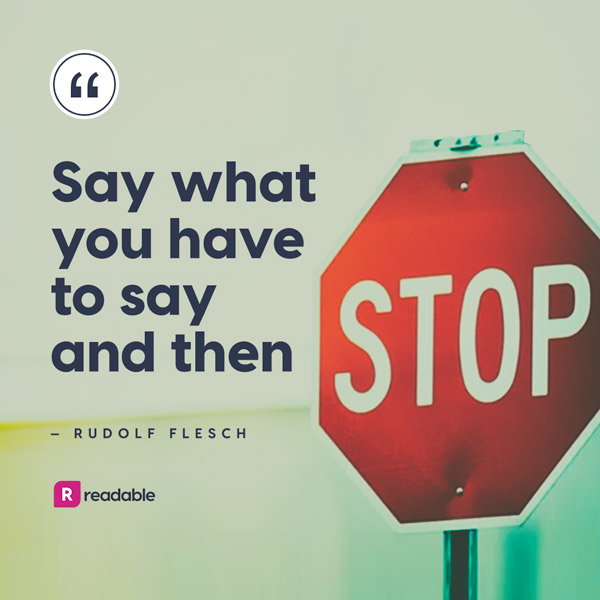
Flesch certainly hadn’t been quiet since his last formula. For decades, he’d been fighting for a revolution in education and arguing for children to be taught phonics. He published several books on reading and writing along the way.
He’d also been working with newspaper publicists to improve the readability of journalism, dramatically increasing readership when it came under threat from television.
An expert in the art of communication, Flesch had branched out from the education sector to advise individuals and businesses on how to finetune their messaging.
By 1975, he was ready to swap his trousers for flares and publish another readability formula – one that would bring his expertise to a new decade and be more easily interpreted than Reading Ease.
With his scientist colleague J Peter Kincaid, he developed the Flesch Kincaid formula in partnership with the US Navy. After rigorous validation for usefulness, the formula soon became a US military standard.
In addition, Flesch Kincaid has since come into standardized use in the insurance industry.
The use of US grades to interpret the score made it so much easier for people to understand. Not only educators and librarians but also parents, authors, copywriters, policymakers, technical writers, journalists… The list goes on.
A text with a Flesch Kincaid grade level between 8 and 10 can be easily understood by the general public.
Flesch Kincaid remains the most widely-used readability formula today, and the plain language movement is more important than ever.
With attention spans shrinking and information coming from a plethora of sources in micro-formats, it’s never been more crucial to finetune your message and make sure it’s heard.
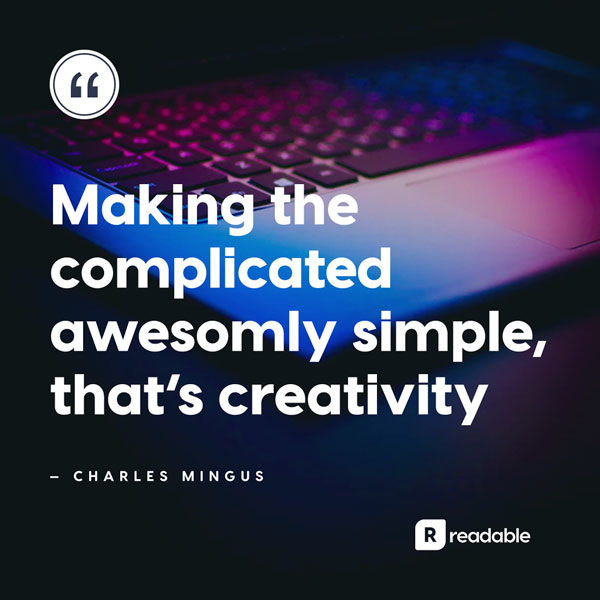
The evolution of communication didn’t stop with Flesch. Regulation continued into the 21st century with doctors being told to simplify their letters and companies being held accountable for the readability of their terms and conditions.
In 2015, Readable was born.
By 2018, ReadablePro had arrived with an unrivaled array of features.
We’re here to make every word of your writing count. Whether you’re a copywriter, marketer or run an online store, Readable will help you improve the readability of your content.
Readability formulas
Flesch Reading Ease (1948)
Highly influential in the readability field, Rudolf Flesch’s Reading Ease formula scores a text between 1 and 100 for readability – the higher the score, the more readable the text is estimated to be.
Schools used to use a conversion table to interpret this as a grade level, which influenced the later release of the Flesch Kincaid formula.
Flesch-Kincaid (1975)
The Flesch-Kincaid grade level was created by Rudolf Flesch as a development of his Reading Ease calculation.
It calculates the estimated US education grade a reader needs to be reading at to understand a piece of writing.
Alongside J Peter Kincaid and the US Navy, he developed it to analyze technical material and training documents.
Since then, it’s become a ubiquitous and widely regarded algorithm with a wide range of uses.
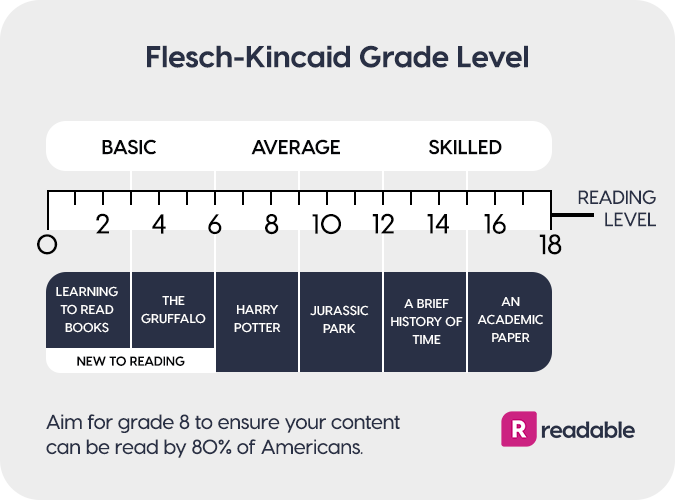
Gunning Fog (1952)
Created by a businessman in the publishing industry, the Gunning Fog Index was originally created as a ‘scathing rebuttal’ to criticisms of Robert Gunning’s writing.
Gunning then discovered that by using the formula, he was able to be aware of any meandering sentences or unclear messaging.
He used it as a tool in his consultancy, Robert Gunning Associates, to help other businesses to achieve their communication goals.
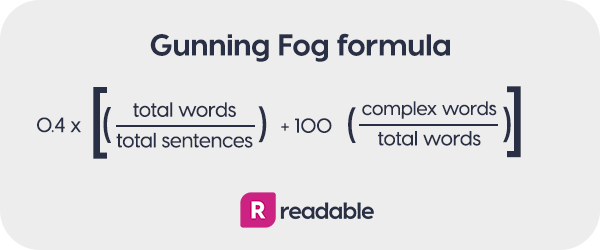
Coleman-Liau (1975)
Created by Meri Coleman and T L Liau, the Coleman-Liau Index came at a time when readability formulas were having a resurgence.
The index doesn’t involve syllable counting but instead counted word length in letters. In this way, it’s similar in variables to the Automated Readability Index.
It has a wide range of usage and has been used in medical documents and translation.
It’s also been used in law to explore the readability of judicial opinions.
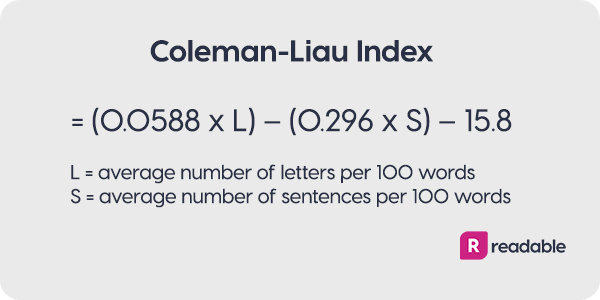
SMOG Index (1969)
The SMOG Index was created by G Harry McLaughlin – a clinical psychologist, who wanted to simplify readability formulas.
McLaughlin’s Simple Measure of Gobbledygook shows that using a lot of words which are polysyllabic reduces readability.
SMOG is considered the “gold standard” in measuring medical writing in the healthcare industry.
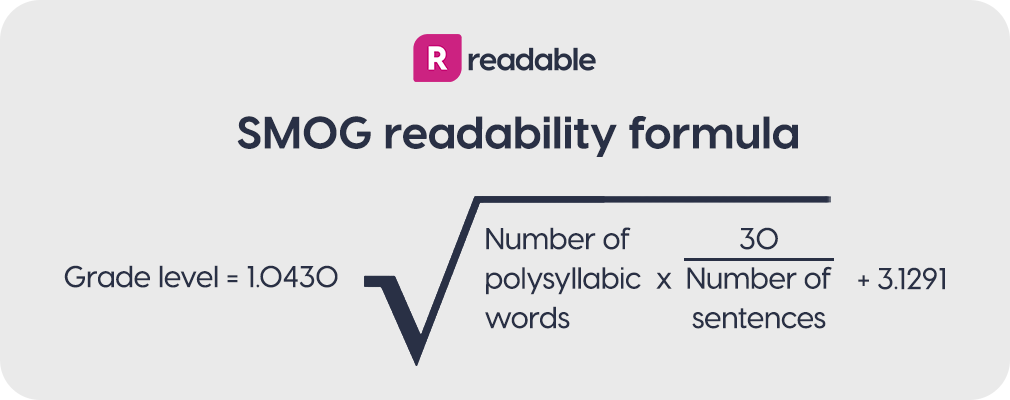
Automated Readability Index (1967)
The use of typewriters in the army demanded a tabulation method for measuring readability.
This is when the Automated Readability Index – ARI – entered the scene.
Measured by a piece of equipment attached to a typewriter, the ARI uses character and word counts as variables. It’s still a popular formula and is particularly useful for technical writing.
FORCAST Grade Level (1973)
Another tool developed for the US army, the FORCAST Grade Level was used to improve personnel training documents.
The main useful feature of FORCAST is that it doesn’t rely on complete sentences to measure readability in a text.
This is really useful if your document has questionnaires, tables, lists or multiple question tests.
Powers Sumner Kearl Grade (1958)
Powers, Sumner and Kearl created their own readability formula based on revised comprehension tests which updated the systems used to test early readability formulas.
They aimed to modernized the criteria in line with a new generation of children and evolving education styles.
It’s a more specialized readability formula which is suitable for elementary texts and not adult tests.
Raygor Readability Graph (1977)
The Raygor readability graph, created by Alton L Raygor, was created with the primary aim of speeding up the process of plotting a readability score on a graph.
It’s influenced by the Fry graph and is used for middle school texts to separate books into age groups.
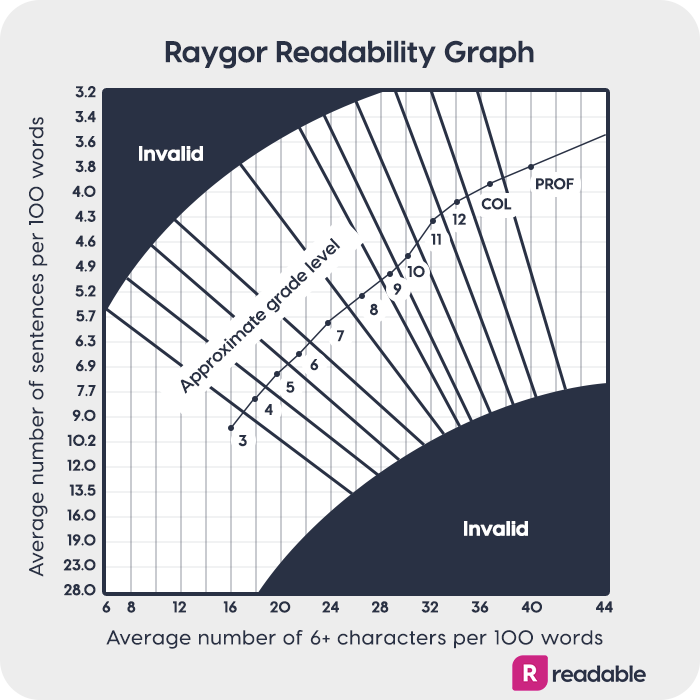
Fry Readability Graph (1963)
Preceding the Raygor formula was the Fry readability graph. Edward Fry created this with the promise of accuracy, and he delivered this in a way that was simple and easy for schools to understand.
Whereas Raygor is more specialized, Fry covers a wide range of age groups. It’s a widely used and respected method and can be used from elementary to college level.
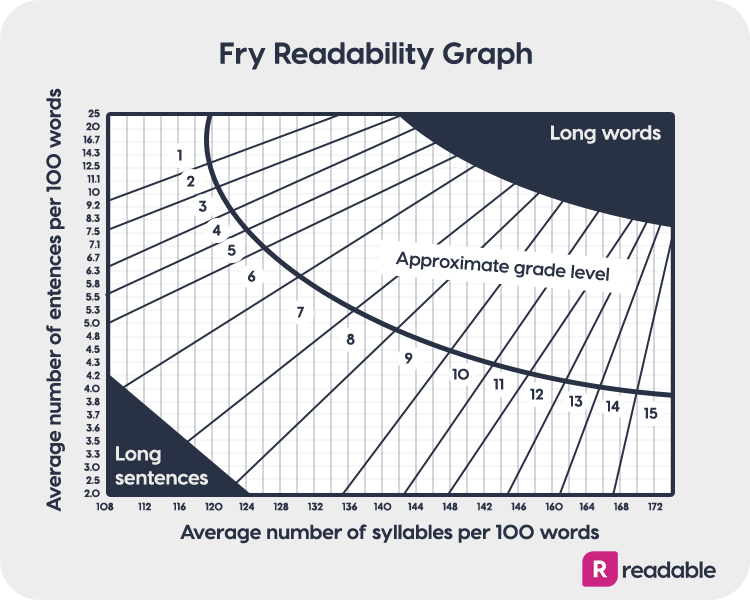
CEFR Level (1989)
The Common European Framework of References for Languages – CEFR – was created for schools and workplaces to analyze language skills.
Now, it’s used by governments to make sure their writing is accessible for a wide audience.
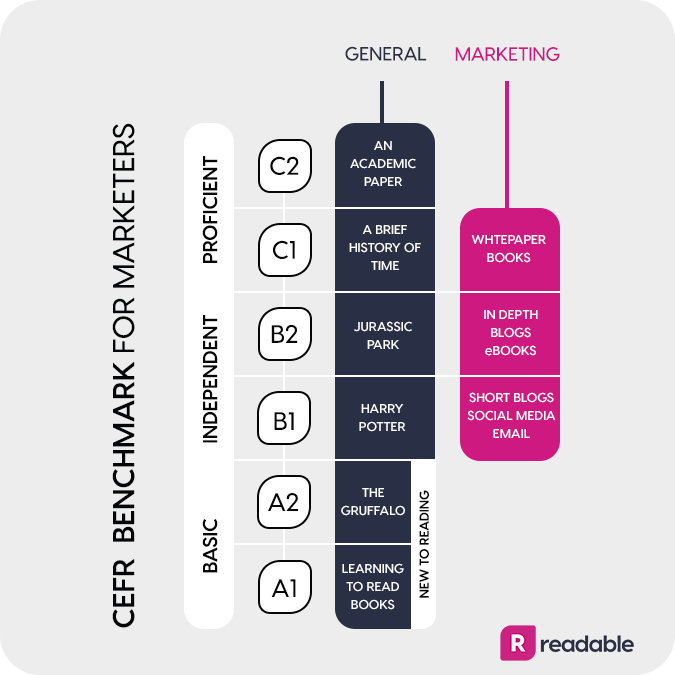
IELTS Level (1980)
The International English Language Testing System – IELTS – is one of the largest English language tests in the world. It’s used to judge someone’s proficiency in writing, listening to and speaking the English language.
In the context of readability, it can be used to make sure your writing doesn’t assume an expert reading of English.
Spache Score (1952)
The Spache formula is a word list based formula. This means it includes a list of everyday words which are deemed familiar for a particular age group.
In this case, it’s a list of words which a child up to fourth grade can typically understand.
The text is compared to this and any difficult or unfamiliar words make it less readable for a young child.
The formula also analyzes sentence length.
New Dale-Chall Score (1995)
Created by Edgar Dale and Jeanne Chall, the New Dale-Chall Score is designed for students fourth-grade or higher within an elementary school.
It’s another word list formula similar to Spache which measures difficult or unfamiliar words in a text.
Lix Readability (1968)
Lix used to be an obscure formula only known in Swedish circles until an investigator pointed out its usefulness for other languages.
Created by Carl-Hugo Björnsson, Lix has been extensively trialed and is useful from elementary to adult texts, giving it a wide range of applications.
Lix can be used with both English and non-English texts.
Lensear Write Formula (1966)
Sometimes misspelled as Linsear-Write, the Lensear Write formula is more focused on writeability and readability and is a quirky calculation designed to help writers strengthen their style.
Created by John O’Hayre who worked in government and abhorred “officialese”.
O’Hayre wrote a book about style which included the formula and encouraged the use of an active voice and direct communication.
Rix Readability Formula (1983)
After learning about the Lix formula, John Aderson was inspired and wanted to give it some more limelight.
He also wanted to refine the process, making it simpler and converting it to a US grade level for easier international use. He did this by creating Rix.
He validated his revised version against several popular readability formulas and confirmed it’s very useful for both English and non-English texts.
How great readability can benefit you
The growth of the internet was completely unforeseen by Rudolf Flesch, Robert Gunning and their contemporaries. Certainly the sheer volume of information we’re being bombarded with daily would be shocking to them.
Worse, with over four billion people and counting now online, the odds are that that bombardment is only going to get worse.
Perhaps it is that volume of information that has led to our shorter attention spans. In 2000, you could rely on holding a reader’s attention for an average of about twelve seconds. That’s now closer to seven seconds. That’s not a long time to get across your message.
In fact, let’s take a moment to put that into perspective. Seven seconds is about the amount of time it will take the average reader to read this tiny paragraph.
That’s it. That’s your window to engage John Q. Public, to convince them to read on.
It’s a little like walking a tightrope – even if you start well, you really want to avoid any distractions.
So it is with content – not only do you need to grab your reader immediately, but you need to ensure you don’t lose their attention.

That’s where readability analysis comes in. A readability score or ratingReadability will tell you how easy your text is to read, and the easier it is to read the better the chance that your readers keeps on reading.
It gives you a set of quantifiable, objective measurements that you can use to set targets, manage expectations and monitor your output.
Studies since the 1940s have shown, repeatedly, the benefits of great readability. Even a small improvement can have a dramatic effect on measurable results.
Readability tools
If you’ve made it this far, you’ll likely have a good idea that we love readability… So much so, we’ve created our own readability tool – ReadablePro.
While other tools are available, we’re going to spend a few moments to highlight why we think you’ll love ReadablePro.
With ReadablePro, we make scoring your text, website or batch of files very easy. Once your text has been added, hooked or pasted into our tool, we will:
- Display the readability score of your copy, for each of the major readability algorithms we listed earlier
- Give it our own unique readability rating – A is excellent, an E, not so much
- Highlight the areas that need to be improved
- Check your spelling and grammar
- Give you suggestions on how to improve your writing
Plus lots more. If you haven’t tested it out yet, try ReadablePro for free.
ReadablePro began as a project of love, evolving into a viable business that is used all over the world.
We’re still very much a small team, as of May 2019 there are three of us, and we aim to keep the personal touch in everything we do.
By working closely with our subscribers, we regularly enhance our tools to ensure they are as usable as possible.
The future of readability
The development of AI tech means readability is absolutely necessary for the future. This is because the development of AI devices such as the Amazon Alexa involves natural language generation – NLG.
NLG technology is what allows Alexa to talk to you as similar to a human as possible.
For this to be achieved, bots need to interact in a way the average person can understand. This is where readability scoring comes in – otherwise bots may not talk on the consumer’s level.
The rise of AI home assistants also means voice search has become more common, having an impact on the way content marketing is communicated.
This has also had an impact on the way Google understands searches. Hummingbird was introduced to focus more on an individual’s search intent, based on semantics.
People are now more likely to frame their Google search as a question. This means anticipating what the questions about a topic may be and answering them within your content in a way that’s simple and easy to understand.
Of course, this also means that within the last few years, readability has become well-recognized as an invaluable SEO tool.
Google loves readability because it improves UX – content which is easier to understand will be easier to navigate and will encourage readers to stay on your page. This, in turn, improves bounce rates.
Readability tools are now quicker and easier than ever to use – ReadablePro uses a wide range of algorithms to create a unique readability rating which is easy to understand and improve.
Straightforward readability scoring lends itself to creating straightforward content that succeeds.
Plain language as an issue also has wider societal importance and continues to influence policy – including GDPR, insurance policy and healthcare.

